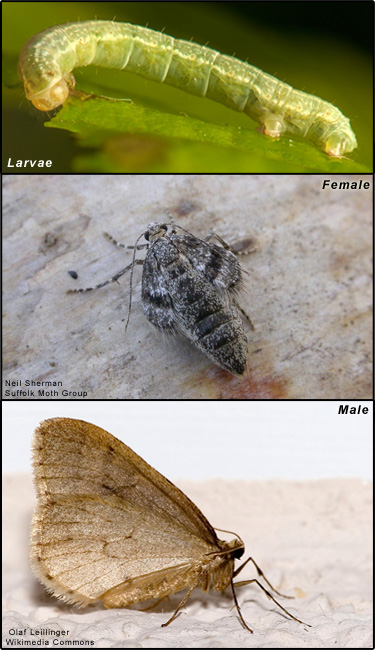Winter moth (Operophtera brumata)
 Description: Introduced to North America from Europe in Nova Scotis sometime prior 1950.
Description: Introduced to North America from Europe in Nova Scotis sometime prior 1950.Identification: Females are small (8mm), gray and wingless. Males are small (wingspan of 20-25mm), light brown to tan in color and their wings have a fringed appearance along the hind margins. Larvae are pale green caterpillars with a white stripe running down each side of the body.
Hosts: Native to Europe. Most common hosts include oak, maple, basswood, white elm, crabapples, apple, and blueberry.
Life Cycle: Females deposit eggs loosely in bark crevices, under bark scales, under lichen, or elsewhere. Adult moths then die and eggs over-winter. Eggs are dark-colored turning orange within 2-4 weeks. Prior to hatching they turn red and eventually a deep, shiny blue.
Impact and Damage: Young larvae or caterpillars' tunnel into and feed inside buds, especially on fruit trees in the early spring before bud break. Delayed bud opening due to cool weather can lead to bud death as caterpillars have longer time to feed. Older larvae feed on expanding leaf clusters.
Similar species: Fall cankerworm (Alsophila pometaria), bruce spanworm moth (Operophtera bruceata), and the spring cankerworm (Paleacrita vernata).
Monitoring and rapid response: In the pupal stage, ground beetles (carabids) and "oil" beetles (staphylinids) have been used. Dormant oil spray to the trunks and branches may be helpful in over-wintering egg control. Spinosad, insecticidal soap, Sevin and Malathion insecticides, have been shown to be effective. Credits: The information provided in this factsheet was gathered from the Massachusetts Dept. of Agricultural Resources and the University of Massachusetts Extension.
Individual species images that appear with a number in a black box are courtesy of the Bugwood.org network (http://www.invasive.org).Individual photo author credits may not be included due to the small display size of the images and subsequent difficulty of reading the provided text. All other images appear courtesy of Google (http://images.google.com).
Common Name: | Winter moth |
Scientific Name: | Operophtera brumata |
Family: | Geometridae (Geometer moth) |
Habit: | Insects |
